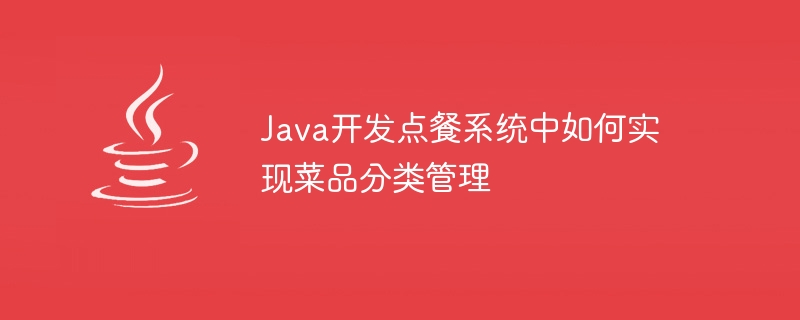Home >Java >javaTutorial >How to implement dish classification management in Java development ordering system
How to implement dish classification management in Java development ordering system
- WBOYWBOYWBOYWBOYWBOYWBOYWBOYWBOYWBOYWBOYWBOYWBOYWBOriginal
- 2023-11-01 13:48:501435browse

How to implement dish classification management in Java development ordering system
In the catering industry, the development of ordering systems has attracted more and more attention, which can greatly improve the quality of restaurants. efficiency and service quality. Among them, dish classification management is an important functional module in the ordering system. This article will introduce how to implement dish classification management in a Java ordering system.
1. Demand analysis
In the dish classification management module, we need to implement the following functions:
- Add dish classification: You can add new dishes to the system Category, including category name, category icon, etc.
- Edit dish category: You can modify existing dish categories, including category names, category icons, etc.
- Delete dish categories: You can delete dish categories that are no longer used from the system.
- Query dish classification: Fuzzy query of dish classification can be carried out based on keywords, which is convenient for quickly locating the required classification.
- Display dish categories: Display the list and details of dish categories in the system for users to view.
2. Technology Selection
When developing the ordering system in Java, we can choose to use some common technologies and frameworks to implement the dish classification management module, such as:
- Spring Boot: Used to quickly build a project framework, providing rich development components and convenient configuration.
- MyBatis: used for database operations, providing powerful SQL mapping functions.
- Thymeleaf: used for rendering front-end pages and supports the use of template engines.
- Bootstrap: used for front-end page development, providing rich style components and responsive layout.
- Maven: Used for project dependency management, simplifying project construction and deployment.
3. Database design
In the database, we need to design two tables to store dish classification information:
- category table: for Store basic information of dish classification, including classification ID, classification name, classification icon, etc.
- dish table: used to store specific information about dishes, including dish ID, dish name, category ID, etc.
Through the association between the category table and the dish table, we can realize the relationship between the dish classification and specific dishes.
4. Backend implementation
In the backend code, we need to implement the following functions:
- Add dish classification: by receiving the classification information incoming from the front end , call the DAO layer method to store it in the database.
- Edit dish classification: According to the received classification ID, call the DAO layer method to update the corresponding classification information in the database.
- Delete dish classification: According to the received classification ID, call the DAO layer method to delete the corresponding classification information in the database.
- Query dish classification: By receiving the keywords passed in from the front end, call the DAO layer method to perform fuzzy query, and return the query results to the front end.
- Display dish classification: Query all dish classification information in the database and return the results to the front end for display.
When implementing the above functions, it is necessary to complete the writing of the DAO layer, Service layer and Controller layer in sequence, and carry out reasonable interface design and error handling.
5. Front-end implementation
In the front-end code, we need to implement the following functions:
- Add dish classification: Provide a form page where users can fill in classification information , and send the data to the backend via Ajax request.
- Edit dish classification: Provide a form page to display existing classification information and allow users to modify and submit data.
- Delete dish category: Provide a confirmation pop-up window. After confirmation, send an Ajax request to pass the category ID to be deleted to the backend.
- Query dish category: Provide a search box. After the user enters the keyword, an Ajax request is triggered and the results are displayed on the page.
- Display dish classification: Render the data returned by the backend to the page through the template engine to display all dish classification information.
Improve user experience and operational convenience through reasonable layout and interaction design.
6. Summary
Through the above steps, we can complete the development of the dish classification management module. Through reasonable demand analysis, technology selection and database design, combined with the implementation of back-end and front-end, a fully functional and user-friendly ordering system can be realized. At the same time, during the development process, functions can be expanded and optimized according to actual needs to improve system performance and stability.
The above is the detailed content of How to implement dish classification management in Java development ordering system. For more information, please follow other related articles on the PHP Chinese website!

